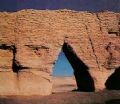
Hexi Corridor
Hexi Corridor or Gansu Corridor refers to the historical route in Gansu province of China. As part of the Northern Silk Road running northwest from the bank of the Yellow River, it used to be the most important passage from ancient China to Xinjiang and Central Asia for traders and the military.
As early as the first millennium BC silk goods began appearing in Siberia having traveled over the Northern Silk Road including the Hexi Corridor segment. The ancient trackway formerly passed through Haidong, Xining and the environs of Juyan Lake, seving an effective area of about 215,000 km². It was an area where mountain and desert limited caravan traffic to a narrow trackway where fortification could control who passed.
More specifically, Hexi is a long narrow passage stretching for about 1000 km from the steep Wushaolin hillside near the modern city of Lanzhou to the Jade Gate[3] at the border of Gansu and Xinjiang. There are many fertile oases along the path. The strikingly inhospitable environment surrounds them: the vast expanse of the Gobi desert, the snow-capped Qilian Mountains to the south, the Beishan mountainous area, and the Alashan Plateau to the north.
Zhangqian's Exploration
In the first millennium BC silk goods began turning up in Siberia having traveled over the North China Silk Road including the Hexi trail segment. The major turning point in the history of the Silk Road was The Han Emperor Wu dispatching the explorer Zhang Qian to explore the mysterious kingdoms to the west and to form an alliance with the Yuezhi people in order to combat the powerful Mongol tribe of the Xiongnu. (Qian, 109 BC)
Exploring the Dayuan kingdom and its capital Ferghana, under Greek influence from about 400 to 200 BC, Zhang Qian observed a population of several hundred thousand farming wheat, rice and grapes (for wine) inhabiting over 70 fortified cities; The Dayuans were . He found the nomadic Yuezhi people centered 1250 kilometres west of Dayuan north of the Gui River. South of the Gui in present day Afganistan, he also visited Bactria, a kingdom of about one million people with similar urban characteristics to Danyuan. From these encounters he learned of more distant civilisations such as Parthia, whose people farmed grain and grapes and produced silver coins with images of their king; the Parthians were said to write their records on leather.
The North Silk Road
After Zhang Qian's return, the Han Dynasty allied with the Yuezhi pushed the Xiongnu back and trade and cultural exchange flourished along the northern Silk Road. Goods moving by caravan to the west included gold, rubies, jade, spices, textiles, coral, ivory and art works. In the opposite direction moved bronze weapons, furs, ceramics and cinnamon bark. Along the Silk Road skilled artisans produced fine finished goods from raw silk, fine jewels from crude stones and exquisitely carved jade figures. This "value added" nature of the Silk Road differentiated it from routes merely transporting goods..
Numerous Han envoys were sent west, some parties exceeding 100 members. The Han Dynasty sent one mission to Parthia, which was reciprocated at around 100 BC: Roman emissaries were captured by the Chinese in 30 BC along the Silk Road at Yongchang. Later a Chinese envoy reached the Roman Emperor Augustus Caesar, who reigned between 27 BC and 14 AD; (Florus, 25 BC) Several Roman ambassadors reached China after 166 AD.
Influence of Buddhism
The Silk Road was the mechanism for the eastward spread of Buddhism, and impressive ancient monuments testify to that early cultural contact. As a bi-product of the Han Dynasty campaigns against the Xiongnu, returning armies brought back Buddhist artifacts as early as 120 BC. Mogao Cave paintings in Dunhuang (along the Silk Road) describe Emperor Wu worshiping Buddhist statues. (UNESCO, 2007) Later Buddhist influence along the Silk Road is found at the Yungang Grottoes where, beginning in the late 5th century AD, a series of stone carvings were created in 252 caves, producing over 51,000 Buddhas. From these early Buddhist pilgrimages on the Silk Road has derived a profound religious influence on the Chinese people that endures today.
Excessive damming of the Shule River and regional livestock overgrazing is causing ongoing desertification in northern China, which is presently threatening the ancient statuary and frescoes of the Yungang caves. Rapid expansion of the Kumtag Desert and other dunes formations threaten to engulf Yungang and other archaeological sites, the present rate of total northern China desertification exceeding 1000 square miles per annum..This pattern of questionable resource management impacting archaeological resources is seen elsewhere in modern China such as on the Yangtze River.
 China Tours inclusive of visiting Jiayuguan China Tours inclusive of visiting Jiayuguan
|